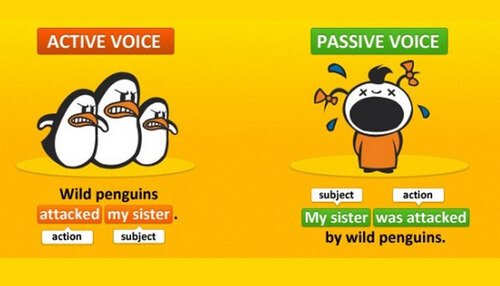Mastering the intricacies of passive sentences is a vital skill for success in IELTS writing. In this article, we will explore three key aspects of passive sentences in IELTS grammar, unraveling their general structure, the utilization of “be going to” for future events, and the incorporation of reporting verbs for precision and formality.

- General Structure of Passive Sentences
The foundation of constructing passive sentences lies in a structured formula:
Subject + (Auxiliary Verb) + “be” + Past Participle (V3) + (By + Doer).
This structure allows for flexibility in sentence formation, enabling candidates to showcase a range of grammatical structures.
For instance:
Active Voice: “The artist (subject) painted (verb) a beautiful mural.”
Passive Voice: “A beautiful mural (subject) was (auxiliary verb) painted (past participle) by the artist.”
Understanding and employing this structure not only adds variety to your writing but also demonstrates a nuanced command of English grammar, a key aspect evaluated in the IELTS examination.
- “Be Going To” in Passive Constructions
Adding a temporal dimension to passive sentences, the inclusion of “be going to” is particularly relevant when discussing future events or plans.
The structure involves: Subject + Is/Are (Not) + Going To Be + Past Participle (V3).
Example:
Active Voice: “The team (subject) will (auxiliary verb) complete (verb) the project next month.”
Passive Voice: “The project (subject) is (auxiliary verb) going to be (auxiliary verb) completed (past participle) by the team next month.”
This construction not only showcases your ability to use passive structures effectively but also highlights your proficiency in expressing future actions with precision.
- Reporting Verbs:
Integrating reporting verbs into passive constructions adds a layer of formality and objectivity to your writing. Common reporting verbs include ‘agree,’ ‘believe,’ ‘claim,’ ‘predict,’ and others. The structure involves:
“It is + Past Participle (V3) + that + Clause.”
Example:
Active Voice: “Scientists (subject) claim (reporting verb) that climate change is inevitable.”
Passive Voice: “It is (subject) claimed (reporting verb) that climate change is inevitable by scientists.”
By incorporating reporting verbs, you not only convey information effectively but also infuse a level of sophistication and academic tone into your writing, essential for success in the IELTS examination.
In conclusion, a nuanced understanding of passive sentences in IELTS grammar involves mastering their general structure, incorporating “be going to” for future events, and skillfully using reporting verbs. These three insights collectively contribute to not only meeting the grammatical expectations of the IELTS exam but also elevating the overall quality and sophistication of your written expression. As you incorporate these elements into your writing practice, you’ll be better equipped to navigate the complexities of IELTS grammar with confidence and competence.
